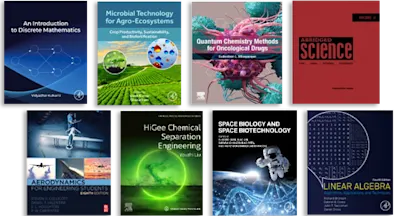
Advances in Immobilized Enzymes for Environmental Stewardship
- 1st Edition - March 1, 2026
- Latest edition
- Editors: Muhammad Bilal, Hubert Cabana
- Language: English
- Paperback ISBN:9 7 8 - 0 - 4 4 3 - 4 1 4 1 5 - 2
- eBook ISBN:9 7 8 - 0 - 4 4 3 - 4 1 4 1 6 - 9
Advances in Immobilized Enzymes for Environmental Stewardship highlights the latest advancements in enzyme technology and explores the design and development of bioreactors for la… Read more

Advances in Immobilized Enzymes for Environmental Stewardship highlights the latest advancements in enzyme technology and explores the design and development of bioreactors for large-scale applications. The book also delves into the challenges of enzyme-driven bioprocesses, providing valuable insights for future research and practical implementations. It offers a comprehensive overview of cutting-edge biocatalysis and enzyme immobilization techniques, while also focusing on removing emerging pollutants through biopolymers and nanocarriers, addressing stability, cost, and reusability issues.
- Provides a comprehensive understanding of immobilized enzymes for the removal of emerging pollutants in the environment
- Describes recent advances in biocatalysis, fundamental design concepts and immobilizing enzymes onto biopolymers and nanocarriers
- Highlights the current obstacles associated with the enzyme-driven bioprocess applications, design, and development of bioreactors, and long-term operations of enzymes
Researchers, academics, and professionals interested in environmental science, pollution, biotechnology, and waste management
Part 1: Fundamentals
1. Harnessing enzymes for biocatalysis
2. Bi- or multi-enzymatic biocatalytic systems
3. Mechanisms of structural and functional coordination between enzymes and support materials
4. Nanozymes—next generation artificial enzymes
5. Tailoring enzyme microenvironments for robust biocatalysis
6. Advanced computational-aided designing for superior biocatalysis
Part 2: Prospective biopolymers-based immobilized enzymes for environmental biotechnology
7. Alginates-immobilized enzymes for environmental remediation
8. Chitin and chitosan-immobilized enzymes for pollutants removal
9. Cellulose and derivatives-immobilized enzymes for environmental remediation
10. Agarose/Agar-agar-immobilized enzymes for environmental remediation
11. Carrageenan-immobilized enzymes for environmental remediation
12. Hybrid polymers-based supports for enzyme immobilization and environmental applications
13. Natural inorganic supports for enzyme immobilization and environmental applications
Part 3: Prospective nanomaterials-conjugated enzymes for environmental biotechnology
14. Carbon based nanocarriers for biocatalytic remediation of micropollutants
15. Metal-based nanobiocatalytic system for biodegradation of environmental pollutants
16 Polymer-based nanomaterials for bioremediation of emerging contaminants
17. Silica nanocarriers-based enzymes for environmental remediation
18. Magnetic biocatalysts for wastewater treatment
19. Nanozyme-based processes for emerging contaminants bioremediation
20. Biocatalytic membranes with crosslinked enzyme aggregates for micropollutant removal
21. Multi-enzyme immobilized nanostructures for expanding bio-catalysis scope
22. Immobilized‐laccase bioreactors for wastewater treatment Part 4- Economic assessment, Challenges, and future perspectives
23. Artificial intelligence to illuminate enzyme immobilization for biocatalysis and environmental biotechnology
24. Techno-economic feasibility, and environmental impacts of immobilized enzymes for environmental biotechnology
25. Case study: Immobilized enzyme technology for large-scale wastewater treatment
1. Harnessing enzymes for biocatalysis
2. Bi- or multi-enzymatic biocatalytic systems
3. Mechanisms of structural and functional coordination between enzymes and support materials
4. Nanozymes—next generation artificial enzymes
5. Tailoring enzyme microenvironments for robust biocatalysis
6. Advanced computational-aided designing for superior biocatalysis
Part 2: Prospective biopolymers-based immobilized enzymes for environmental biotechnology
7. Alginates-immobilized enzymes for environmental remediation
8. Chitin and chitosan-immobilized enzymes for pollutants removal
9. Cellulose and derivatives-immobilized enzymes for environmental remediation
10. Agarose/Agar-agar-immobilized enzymes for environmental remediation
11. Carrageenan-immobilized enzymes for environmental remediation
12. Hybrid polymers-based supports for enzyme immobilization and environmental applications
13. Natural inorganic supports for enzyme immobilization and environmental applications
Part 3: Prospective nanomaterials-conjugated enzymes for environmental biotechnology
14. Carbon based nanocarriers for biocatalytic remediation of micropollutants
15. Metal-based nanobiocatalytic system for biodegradation of environmental pollutants
16 Polymer-based nanomaterials for bioremediation of emerging contaminants
17. Silica nanocarriers-based enzymes for environmental remediation
18. Magnetic biocatalysts for wastewater treatment
19. Nanozyme-based processes for emerging contaminants bioremediation
20. Biocatalytic membranes with crosslinked enzyme aggregates for micropollutant removal
21. Multi-enzyme immobilized nanostructures for expanding bio-catalysis scope
22. Immobilized‐laccase bioreactors for wastewater treatment Part 4- Economic assessment, Challenges, and future perspectives
23. Artificial intelligence to illuminate enzyme immobilization for biocatalysis and environmental biotechnology
24. Techno-economic feasibility, and environmental impacts of immobilized enzymes for environmental biotechnology
25. Case study: Immobilized enzyme technology for large-scale wastewater treatment
- Edition: 1
- Latest edition
- Published: March 1, 2026
- Language: English
MB
Muhammad Bilal
Muhammad Bilal is working as an Associate Professor at the Faculty of Civil and Environmental Engineering, Gdansk University of Technology, Poland. Previously, he served as an assistant/associate Professor at Poznan University of Technology, Poland, and the School of Life Science and Food Engineering, Huaiyin Institute of Technology, Huaian, China. He earned his Ph.D. from Shanghai Jiao Tong University, specializing in bioengineering and applied biotechnology. His main research activities are oriented to Environmental biotechnology, nanotechnology, enzyme engineering, immobilization, chemical modifications, and industrial applications of microbial enzymes, liquid, and solid waste management. He has authored over 700 peer-reviewed articles, 150 book chapters, 25 edited books. Dr. Bilal is the associate editor of Frontiers in Chemical Engineering and Frontiers in Environmental Science (Frontiers), and an editorial board member for several journals. He was listed as a highly cited researcher (Clarivate) in 2021 and holds several "highly cited papers" in WOS.
Affiliations and expertise
Associate Professor, Department of Sanitary Engineering, Faculty of Civil and Environmental Engineering, Gdańsk University of Technology, Gdańsk, PolandHC
Hubert Cabana
Prof. Hubert Cabana is an expert in environmental biotechnology (mainly fungal and enzymatic processes) dedicated to the elimination of emerging contaminants (e.g. endocrine disrupters, pharmaceutical compounds) present in wastewater and biosolids. In the past 10 years of research, he has developed innovative approaches for the development of enzymatic bioprocesses, such as new generation of LME-based reusable biocatalysts and bioreactors.
Affiliations and expertise
Professor, Université de Sherbrooke, Canada